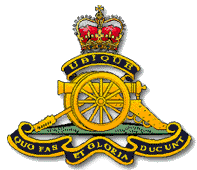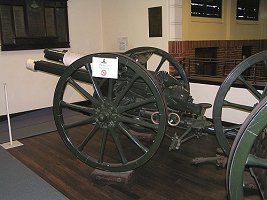
7th Field Battery, 3rd Field Regiment RAAHISTORY
The origins of the 7th Field Battery, 3rd Field Regiment and artillery in Western Australia can be traced back to 19 July 1870. It was on this date that the Union Troop of Western Australian Volunteers was formed in the fledgling colony under the command of Lieutenant de Lisle. Soon afterwards this unit, under the new command of Captain Blundell, an officer of the British Royal Horse Artillery, took possession of two 12 pounder field artillery pieces and became known as the West Australian Troop of Volunteer Horse Artillery. By the 1890’s the unit, having undergone further name changes had become known as 1st Battery Field Artillery and replaced its unsuitable 12 pounders for more modern 9 pounders. It was also during this period leading up to Federation that a number of the unit’s members volunteered for service in the Boer War in South Africa. One of these men, Lieutenant Bell, was awarded the Victoria Cross for conspicuous gallantry.

12 Pounder Breech Loading Field Gun

9 Pounder Breech Loading Field GunOn Federation, military units within Western Australia were grouped together under the command of Lieutenant Colonel Hobbs and became known as the West Australian Mixed Brigade. When compulsory military training was introduced in 1911, field artillery within Western Australia was designated as 14th Battery Australian Field Artillery. By 1914 compulsory military training had seen the unit expand into two batteries known as 37th and 38th Batteries Australian Field Artillery. Upon the outbreak of the First World War volunteers, consisting mainly of those from within the existing artillery militia units, were grouped together to form Western Australia’s contribution to the 1st Australian Divisional Artillery.
Designated 8th Battery 3rd Field Artillery Brigade the unit was hastily equipped with quick firing 18 pounders and readied for overseas embarkation. The Battery, under the command of Major Bessell-Brown, was amongst the first to see action at Gallipoli. Four of its guns landed on the second day of the landings only to have them returned to the ships later in the day due to the unsuitability of the terrain and the lack of available gun positions. On the night of 1 May 1915, 160 men hauled two of the Battery’s guns into position from which they could provide some support for the infantry. After two days and twenty-two casualties the Divisional Commander, General Bridges, ordered the guns forward into the infantry firing line. From there they successfully fired directly into Turkish trenches at a range of 400m before being withdrawn. On 6 May 1915 this exercise was again attempted only to come under fierce retaliatory fire. This resulted in Major Bessell-Brown and Sergeants Braidwood and Wallis being recommended for decorations by Colonel Hobbs. With news of the forthcoming withdrawal, the Battery’s guns were gradually withdrawn until on 19 December 1915 only one remained. This last remaining gun, under the direction of Major Waite, fired the final round of the campaign before being destroyed by the crew and abandoned. With the Gallipoli campaign behind them the Battery was reorganised and sent to France. Along with the 14th Field Battery, another West Australian Battery, it went on to take part in significant actions on the Western Front where the terrain and nature of the warfare was more suited to artillery.

18 Pounder Field GunFollowing the declaration of war, it was decided to raise three Field Artillery Regiments for service with the second AIF, of which Western Australia was to provide a single battery as it had at the start of the previous war. Under the command of Captain Bessell-Brown this unit, once again comprising mainly of volunteers from the two militia batteries, was designated the 6th Battery, 2/3rd Field Regiment. Once formed, the Battery was transported to New South Wales where it was issued with, and trained on, the 18 pounders. Destined for the Middle East, the Battery was diverted enroute to England where it remained for some time as part of the defence of Britain. Having been issued with the new and more effective 25 pounders, the Battery was finally sent to the Middle East in December 1940 but arrived too late to take part in the capture of Bardia and Tobruk. Subsequently, the Battery took part in the ill-fated Greece and Crete campaigns in which it saw a great deal of influential action. This included the vital rearguard action of Elasson in which the Battery fourght with great courage in support of fellow West Australians of the 2/11th Battalion. Due to the haste and shortage of transportation the Battery was forced to leave all its guns behind in Greece. Consequently they were diverted to Crete with only their personal weapons. On arrival some of the Battery was issued with captured Italian artillery and sent to Retimo in support, once again, of the 2/11th Battalion whilst the remainder were converted to infantry. In the military defeat that followed, many within the Battery, despite their determination and courage, were captured and spent the remaining years of the war in POW camps scattered across Europe. On their return to Egypt the survivors were quickly regrouped and reinforced to reform the Battery. The Battery was returned to Australia in 1942 to take part in the Battle of Australia before spending the remainder of the war in action throughout the South West Pacific. As in the previous war a second West Australian Battery, the 14th, was raised from the militia 3rd Field Brigade as part of the 2/7th Field Regiment. This Battery saw significant action in the Middle East, including the Battle of El Alamein, in which artillery played a key role in the victory, and later in Indonesia.

25 Pounder Field GunAfter the war these units were disbanded before being raised again in 1948 as P and Q Batteries of the 3rd Field Regiment. They were once again comprised of purely militia volunteers. In 1965 the unit again adopted the usage of 7th and 8th Batteries in place of P and Q Batteries and in 1973 the Regiment was reduced to one field battery and a HQ battery. In 1975 the unit was again reduced to its current composition of one field battery designated the 7th Field Battery, 3rd Field Regiment. In recent times the Battery has been integrated into 13th Brigade. It has been given the duty of providing fire support for the Brigade’s units in their role of vital asset protection in the Pilbara. On 1 September 1994 the Battery reverted under command of the 2nd Division Artillery from Land Head Quarters. The Battery currently consists of a Headquarters element, eight 105mm M2A2 Howitzers and other supporting elements with an overall establishment strength of 136.

105mm L5 Pack Howitzer

105 mm M2A2 Howitzer
